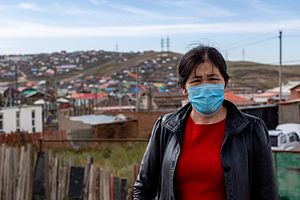Read part one of this series on climate change, migration, mining, and economic stability in Mongolia.
Nearly half of Mongolia’s entire population lives in its capital, Ulaanbaatar. 1.5 million people call the city home. Rapid urbanization has put a massive strain on the capital and has created a host of problems that are challenging for the government to handle. Worst of all is air pollution.
Despite government efforts to stem the pollution crisis, Ulaanbaatar remains one of the most polluted cities on earth, particularly in the winter months. It is fifth in the world in terms of PM2.5 (fine particles) air pollutants.
This year, in an effort to cut back on air pollution levels, the government banned coal. Coal is the primary heating and energy source for the sprawling city, from its heart to the informal ger districts. The government has proposed using another form of longer-burning charcoal and wood instead.
The city of Ulaanbaatar is set into a bowl-shaped valley. This geography contributes to a phenomenon called inversion, in which the air pollution acts like a smog lid sitting atop the city, trapping particulate matter and gases.
One main issue is the smoke. Coal is burned by Mongolians for cooking and to stay warm during the winter. It is estimated that 10,000 households move to Ulaanbaatar per year and there is no end in sight despite government attempt to stem the influx. Rural migrants settle in informal ger districts, where there is no formal infrastructure or services. A government ban on migrants settling in these areas has had little impact.
In Bayankohsuu district, which is the most polluted district of Ulaanbaatar, pollution levels reach much higher than in the rest of the city. The area has seen the biggest population increase in the last decade. It’s population is the poorest and the district has some of the capital’s worst infrastructure. The burning of coal has been substantially higher here than in other parts of the city.
At Bayanzurkh hospital, Joohak Lee, a doctor from South Korea, sees as many patients as he can a few weekends per year to relieve local doctors. Bayarma, a 13-year-old girl is being treated for heart problems and indigestion. In combination with severe pollution-related illnesses, many Mongolians consume high levels of meat and have high blood pressure.
Children are at an even higher risk as they breath twice as fast and are outside longer per day than most adults. It is estimated that 50 percent of children suffer from air pollution-related illnesses. Respiratory, cardiovascular and neurological impairments abound among children and pregnant women in the city. As one of the most polluted cities in the world in the winter, one in 10 die of air pollution-related causes. “If coal was not available, people would burn old tires to stay warm in the coldest months of winter,” says Lee.
Residents have taken up short term solutions such as using masks, air purifiers, and cleaner burning stoves. Residents new and old must prepare for the winter soon approaching. Coal may be dirty, but freezing is not a pleasant alternative.
Mongolia adopted a national air pollution mitigation plan in March 2017 in response to its severe air pollution. The plan aims to reduce the current levels of air pollution by 80 percent by 2025. However, the Mongolian government is also planning more than six new coal power plants over the next decade in the absence of a coherent national energy strategy. The dominance of coal in Mongolian energy plans for new power facilities in Ulaanbaatar, together with the country’s aging power plants, transmission and distribution networks, have contributed to the creation of a highly inefficient energy sector.
The result is that Ulaanbatar continues to have one of the highest levels of air pollution in Asia and in the world. Although most severe between October and March, its average PM2.5 levels put it in the top five globally. The air pollution situation has become so severe that has been labeled a health crisis, particularly for children who continue to suffer the most where essential infrastructure was either never built or was poorly developed.
The current recovery is expected to accelerate with a GDP growth rate averaging more than 6 percent between 2019 and 2020 expect, driven by large foreign direct investments in mining. As the country experiences a new, but more modest boom, it will still have to face its most serious economic, environmental, and urban crises head on in combination with more government reforms to secure more stability for the country long term.
Nicholas Muller is an American photojournalist and writer.












































